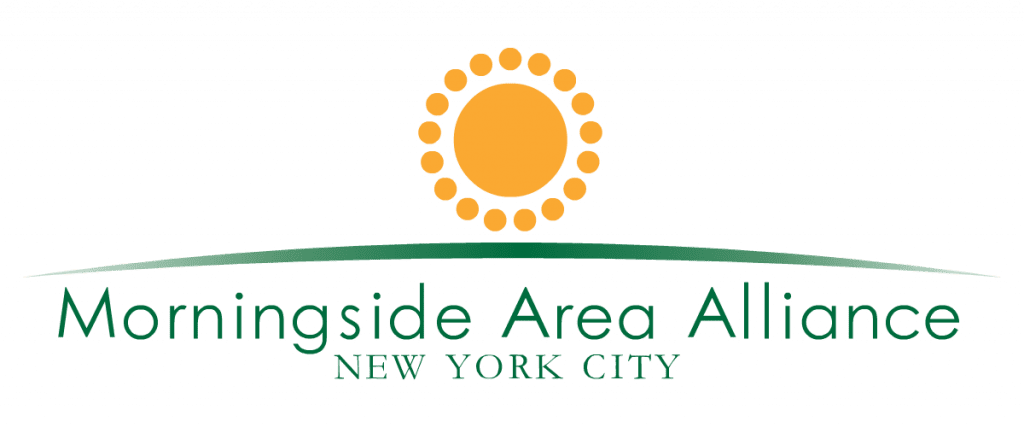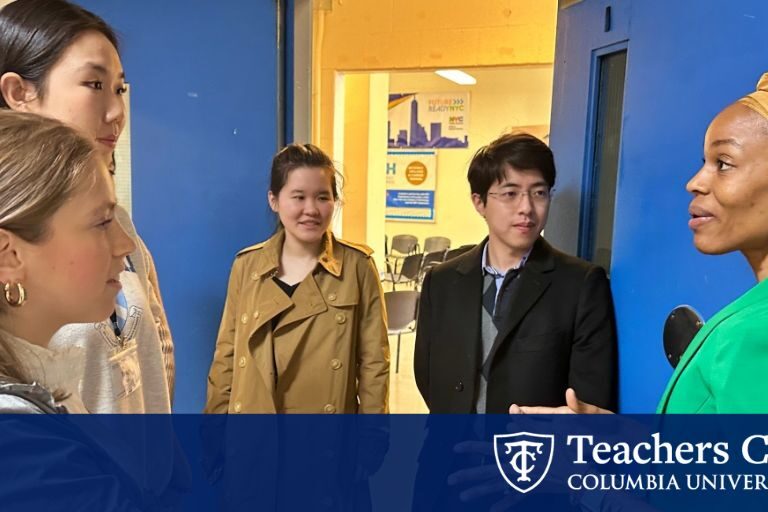Building upon classroom teaching experiences, 14 TC Mathematics Education students gained additional first-hand insight on how teaching practices unfold across a variety of New York City educational institutions in a special STEM study tour led by TC’s Rochy Flint this spring. Different approaches and outcomes to hands-on learning, culturally-responsive teaching, resource distribution and more played out in the wide-reaching, week-long experience that allowed TC students to observe how math pedagogy techniques impact pupils across six schools and two museums.
“Seeing pedagogy applied to create opportunities enabled students to appreciate the rich tapestry of New York City education in an innovative way,” explains Flint, a lecturer in the Mathematics, Science and Technology Department. “Observing how education leaders, many of whom are also TC alumni, weave different ideas together to cater to their unique communities allowed students to think about applying what they have learned in new ways and see the many rich opportunities available to them.”
So what improves math education in the classroom and beyond? We spoke to some of the hosting TC alumni and students to find out.
Applying Math in Real Life
Students witnessed creative, experiential learning activities applied in numerous settings during the STEM study tour. The unique approach of an innovative technical school in Brooklyn, the Pathways in Technology Early College High School (P-Tech), offered a closer look at an approach designed to address two of education’s greatest challenges: helping students excel in STEM, and facilitating career readiness. A collaboration between three separate NYC education bodies and the IBM Corporation, P-Tech students gain skills in electromechanical engineering or computer information systems — and have the choice to earn an associate’s degree at no additional cost.
“It’s an approach that doesn’t just prepare students academically, but also provides them with real-world skills and connections to industry professionals, which is essential in today’s rapidly changing job market,” noted first-year master’s student Huizhu Wu.
Flint and Rashid Davis (M.A. ’95) [center] with TC Mathematics Education students.
The P-Tech model, which is currently in use at nine NYC schools, is a compelling example of what the future might hold, with new research finding the model increased post-secondary degree completion, especially among male students. For Wu, the possibilities of a “partnership that brings together public schools, higher education institutions and industry leaders to create pathways” are not only endless, but essential to today’s rapidly changing workforce.
The success is closer to TC than one might think. P-Tech’s founding principal is none other than Rashid Davis (M.A. ’95, English Education), who sees applicable skills as the means for choices after graduation, whether that’s in the job market or in higher education, which most P-Tech grads pursue. “[P-Tech’s approach is] really about the power of true collaboration, and not just access, but being intentional about time and resources to opportunity,” explains Davis, also a Cahn Fellow at TC in 2012. Notably, Davis explains, the P-Tech model is more attainable than many often assume due to the school’s partnership with IBM. “It’s really about teaching people how to learn and not having the latest gadgets.”
In addition to meeting Davis at P-Tech, TC students experienced hands-on learning in action at destinations like Brooklyn STEAM Center, the Hewitt School, the Museum of Mathematics (MoMath) and the American Museum of Natural History, where students explored the cultural giant’s exhibits through engaging touchpoints and quizzes focused on climate change.
“It’s one thing to read about these concepts in textbooks, but it’s another to see them brought to life through exhibits and interactive experiences,” said TC student Fangqi Zhu. “These hands-on activities cater to various learning styles and can ignite a student’s lifelong interest in science and the natural world.”
Culturally-Responsive Teaching
Of the eight institutions on this STEM study tour, at least half placed a special emphasis on culturally-responsive teaching. At the bilingual Ann Cross Mersereau Intermediate School in the Bronx, TC alum Andrés Rodríguez-Aponte (M.A. ’19, Mathematics Education) is doing something special.
Rodríguez-Aponte gives bilingual instruction seamlessly throughout his lessons, but also pays extra attention to how students are feeling. With great enthusiasm and positivity, Rodríguez-Aponte cheers on his students while cultivating a culture of confidence in oneself and others to figure out whatever problem is presented.
“Mr. Rodríguez-Aponte in particular created such a wonderful class culture, where the whole class was student centered,” recalls Edwin Geng, “and the students were jumping up at the opportunity to respond,” with a clear commitment to being part of a “learning community.”
Fostering a sense of inclusion is a key part of Rodríguez-Aponte’s style, which includes switching between English and Spanish, and leading his students in daily affirmations (“I am great. I will do great things in life!”). For the teacher, whose Puerto Rican identity helps inform this approach, seamless bilingual instruction allows students to be comfortable in the classroom and with the material.
“It’s okay to be yourself and speak your language, whatever language that is,” says Rodríguez-Aponte, whose studies at the College included preparation for multicultural classrooms. “Being able to speak your language without being judged allows you to take risks mathematically and language-wise.”
But in other classrooms, culturally-responsive education took a different approach. At the Borough of Manhattan Community College, students met with faculty Elisabeth Jaffe (Ed.D. ’10), Kathleen Offenholley (Ph.D. ’07) and Jae Ki Lee (Ed.D. ’16) — who each often used collaboration to help “students see themselves as capable mathematicians,” noted middle school math teacher and TC student Cleha Kodama.
“One of the most challenging aspects of teaching math is helping students believe they can do math and helping them redefine what it means to be good at math,” said Kodama, noting the confidence in the BMCC classrooms. “The most valuable skill I can teach [my students] is not solving quadratics or graphing equations but learning how to think through and overcome challenges.”
Benjamin Dickman (Ph.D. ’14) and Elizabeth Brennan (Ph.D. ’16), who both teach at the Hewitt School, with TC’s Rochy Flint (center).
Creativity & Small Class Sizes
Since teachers alone can’t determine student learning and success, students found that seeing first-hand the ways in which school resources can expand classroom possibilities was a particularly rewarding component of the study tour.
At the Hewitt School, an independent all-girls institution on the Upper East Side, small class sizes and an emphasis on critical thinking allowed class seminars to drive learning. “It reinforced my belief that true education goes beyond rote memorization and standardized testing,” recalled TC student Veronica Sun, noting the passion and curiosity present in the classroom.
That’s precisely what Hewitt teacher Elizabeth Brennan (Ph.D. ’15) was determined to foster from the beginning of her career, seeing an opportunity to empower her students to do more than copy down her work on the white board.
“You can’t learn how to play the piano by watching other people play the piano,” notes Brennan, who fosters creative problem solving by asking students to present different approaches, rather than providing a singular method to solve equations or scenarios. “When everyone has a calculator in their pocket, what is most important now is kids who can think about information critically, grapple with this problem, and figure it out. And that’s not the view of mathematics that most people have.”
For Brennan, the key to success for new math educators lies in not only giving oneself grace, but also embracing the joy of learning. “It should be fun, for the kids and for you…The human brain naturally wants to learn,” says the TC alum, noting the enthusiasm for problem solving she sees in her young children. “Somewhere in middle school, that changes. ‘Tell me what to do to get whatever grade I want.’ You [as a teacher] have to do whatever you can do to keep curiosity and creativity going.”
Elizabeth Brennan (Ph.D. ’15) and Benjamin Dickman (Ph.D. ’14) at the Hewitt School. “I’m blessed to have Benjamin as a thought partner on most things at work,” says Brennan, who encourages early career math teachers to build similar relationships. “Find a mentor/colleague who can support you! Even now in my 21st year teaching, I learn so much from my colleagues.”
What’s Next
Both Flint’s study tour and her recent Multicultural STEMSpaces Gallery Walkthrough illustrate that the future of mathematics education is bound only by imagination.
“I want to encourage people to think more deeply about what it means to engage in mathematics and STEM,” explains Flint, who views experiences like the study tour and the gallery walkthrough as crucial in challenging preconceptions about what mathematics education can look like. “I aim to help my students feel more comfortable in new spaces, leaning into and embracing challenges as opportunities to be celebrated, which they can then pass on to young learners.”
Illuminating “where mathematics learning can happen,” the gallery walkthrough included depictions of math in everyday life and unique learning experiences captured by students. This year, participants included students from Flint’s study tour as well as students from Roni Ellington’s “Multicultural Mathematics Education” course. Established by Flint in 2018, the show was inspired by the interests of former TC faculty member Erica Walker, who has “done groundbreaking work in highlighting mathematical spaces.”
For Flint, the impact of expanding the definition of mathematical learning extends far beyond classroom lessons. She views the endeavor as deeply intertwined with challenging pervasive attitudes — such as self-doubt and anxiety — towards the field.
“Your relationship [to math] is highly influenced by your parents, how society talks about it, and how teachers relate to it,” explains Flint, noting how often people unsolicitedly volunteer that they are “not a math person.” But those barriers may be reduced if educators and leaders can help the public see math and STEM more integrated into their everyday lives.
“Everyone is mathematical,” says Flint. “People are constantly problem-solving.” Flint defines mathematics as “the study of structures.” “The real numbers and school arithmetic are but just one structure in the vast field of mathematics. What other mathematical structures do you observe in the world around you?”
— Morgan Gilbard
Published Monday, Jun 17, 2024

